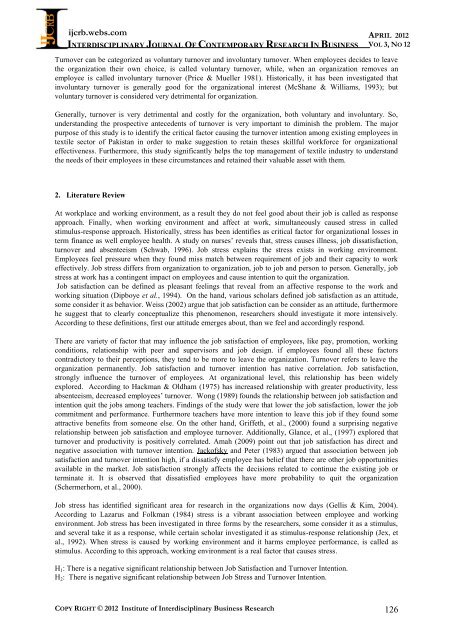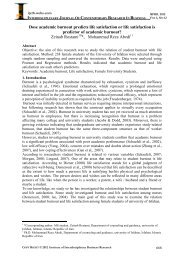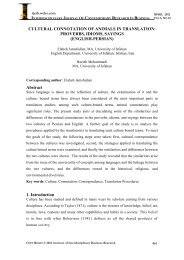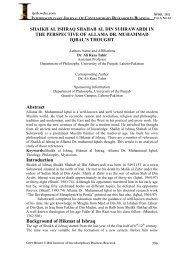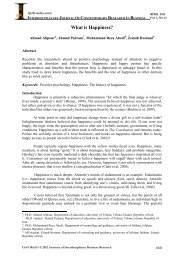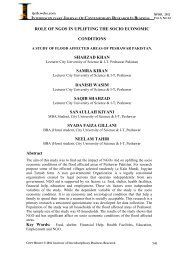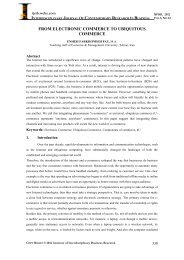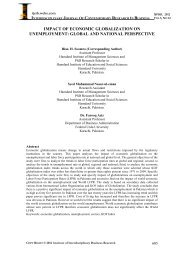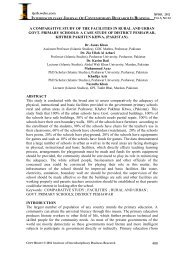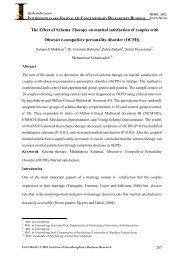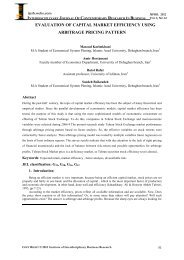Turnover Intention: An HRM Issue in Textile Sector - journal ...
Turnover Intention: An HRM Issue in Textile Sector - journal ...
Turnover Intention: An HRM Issue in Textile Sector - journal ...
You also want an ePaper? Increase the reach of your titles
YUMPU automatically turns print PDFs into web optimized ePapers that Google loves.
ijcrb.webs.com<br />
INTERDISCIPLINARY JOURNAL OF CONTEMPORARY RESEARCH IN BUSINESS<br />
APRIL 2012<br />
VOL 3, NO 12<br />
<strong>Turnover</strong> can be categorized as voluntary turnover and <strong>in</strong>voluntary turnover. When employees decides to leave<br />
the organization their own choice, is called voluntary turnover, while, when an organization removes an<br />
employee is called <strong>in</strong>voluntary turnover (Price & Mueller 1981). Historically, it has been <strong>in</strong>vestigated that<br />
<strong>in</strong>voluntary turnover is generally good for the organizational <strong>in</strong>terest (McShane & Williams, 1993); but<br />
voluntary turnover is considered very detrimental for organization.<br />
Generally, turnover is very detrimental and costly for the organization, both voluntary and <strong>in</strong>voluntary. So,<br />
understand<strong>in</strong>g the prospective antecedents of turnover is very important to dim<strong>in</strong>ish the problem. The major<br />
purpose of this study is to identify the critical factor caus<strong>in</strong>g the turnover <strong>in</strong>tention among exist<strong>in</strong>g employees <strong>in</strong><br />
textile sector of Pakistan <strong>in</strong> order to make suggestion to reta<strong>in</strong> theses skillful workforce for organizational<br />
effectiveness. Furthermore, this study significantly helps the top management of textile <strong>in</strong>dustry to understand<br />
the needs of their employees <strong>in</strong> these circumstances and reta<strong>in</strong>ed their valuable asset with them.<br />
2. Literature Review<br />
At workplace and work<strong>in</strong>g environment, as a result they do not feel good about their job is called as response<br />
approach. F<strong>in</strong>ally, when work<strong>in</strong>g environment and affect at work, simultaneously caused stress <strong>in</strong> called<br />
stimulus-response approach. Historically, stress has been identifies as critical factor for organizational losses <strong>in</strong><br />
term f<strong>in</strong>ance as well employee health. A study on nurses’ reveals that, stress causes illness, job dissatisfaction,<br />
turnover and absenteeism (Schwab, 1996). Job stress expla<strong>in</strong>s the stress exists <strong>in</strong> work<strong>in</strong>g environment.<br />
Employees feel pressure when they found miss match between requirement of job and their capacity to work<br />
effectively. Job stress differs from organization to organization, job to job and person to person. Generally, job<br />
stress at work has a cont<strong>in</strong>gent impact on employees and cause <strong>in</strong>tention to quit the organization.<br />
Job satisfaction can be def<strong>in</strong>ed as pleasant feel<strong>in</strong>gs that reveal from an affective response to the work and<br />
work<strong>in</strong>g situation (Dipboye et al., 1994). On the hand, various scholars def<strong>in</strong>ed job satisfaction as an attitude,<br />
some consider it as behavior. Weiss (2002) argue that job satisfaction can be consider as an attitude, furthermore<br />
he suggest that to clearly conceptualize this phenomenon, researchers should <strong>in</strong>vestigate it more <strong>in</strong>tensively.<br />
Accord<strong>in</strong>g to these def<strong>in</strong>itions, first our attitude emerges about, than we feel and accord<strong>in</strong>gly respond.<br />
There are variety of factor that may <strong>in</strong>fluence the job satisfaction of employees, like pay, promotion, work<strong>in</strong>g<br />
conditions, relationship with peer and supervisors and job design. if employees found all these factors<br />
contradictory to their perceptions, they tend to be more to leave the organization. <strong>Turnover</strong> refers to leave the<br />
organization permanently. Job satisfaction and turnover <strong>in</strong>tention has native correlation. Job satisfaction,<br />
strongly <strong>in</strong>fluence the turnover of employees. At organizational level, this relationship has been widely<br />
explored. Accord<strong>in</strong>g to Hackman & Oldham (1975) has <strong>in</strong>creased relationship with greater productivity, less<br />
absenteeism, decreased employees’ turnover. Wong (1989) founds the relationship between job satisfaction and<br />
<strong>in</strong>tention quit the jobs among teachers. F<strong>in</strong>d<strong>in</strong>gs of the study were that lower the job satisfaction, lower the job<br />
commitment and performance. Furthermore teachers have more <strong>in</strong>tention to leave this job if they found some<br />
attractive benefits from someone else. On the other hand, Griffeth, et al., (2000) found a surpris<strong>in</strong>g negative<br />
relationship between job satisfaction and employee turnover. Additionally, Glance, et al., (1997) explored that<br />
turnover and productivity is positively correlated. Amah (2009) po<strong>in</strong>t out that job satisfaction has direct and<br />
negative association with turnover <strong>in</strong>tention. Jackofsky and Peter (1983) argued that association between job<br />
satisfaction and turnover <strong>in</strong>tention high, if a dissatisfy employee has belief that there are other job opportunities<br />
available <strong>in</strong> the market. Job satisfaction strongly affects the decisions related to cont<strong>in</strong>ue the exist<strong>in</strong>g job or<br />
term<strong>in</strong>ate it. It is observed that dissatisfied employees have more probability to quit the organization<br />
(Schermerhorn, et al., 2000).<br />
Job stress has identified significant area for research <strong>in</strong> the organizations now days (Gellis & Kim, 2004).<br />
Accord<strong>in</strong>g to Lazarus and Folkman (1984) stress is a vibrant association between employee and work<strong>in</strong>g<br />
environment. Job stress has been <strong>in</strong>vestigated <strong>in</strong> three forms by the researchers, some consider it as a stimulus,<br />
and several take it as a response, while certa<strong>in</strong> scholar <strong>in</strong>vestigated it as stimulus-response relationship (Jex, et<br />
al., 1992). When stress is caused by work<strong>in</strong>g environment and it harms employee performance, is called as<br />
stimulus. Accord<strong>in</strong>g to this approach, work<strong>in</strong>g environment is a real factor that causes stress.<br />
H 1 : There is a negative significant relationship between Job Satisfaction and <strong>Turnover</strong> <strong>Intention</strong>.<br />
H 2 : There is negative significant relationship between Job Stress and <strong>Turnover</strong> <strong>Intention</strong>.<br />
COPY RIGHT © 2012 Institute of Interdiscipl<strong>in</strong>ary Bus<strong>in</strong>ess Research 126


